.
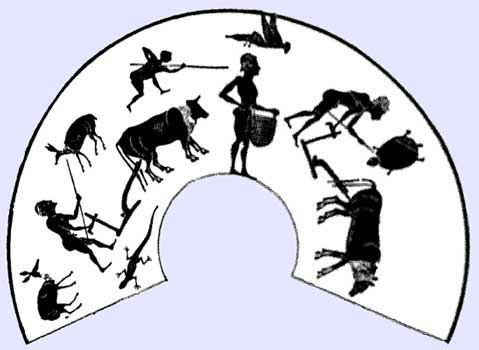
Agriculture was the foundation of the Ancient Greek economy. Nearly 80% of the population was involved in this activity[1]. An excellent area of activity for a citizen, it gave birth to a way of life and mores which persisted throughout Antiquity[2].
Environment
With the exception of the Anatolian coastal cities, Greece presented relatively homogenous natural conditions. The mountains represent 80% of available space, and as much as 90% for the islands of the Aegean Sea. This significantly reduced the space available for agriculture and animal husbandry. What ground is available is of poor, stony quality. Only a few rare plains such as those of Messenia qualify as being fertile.
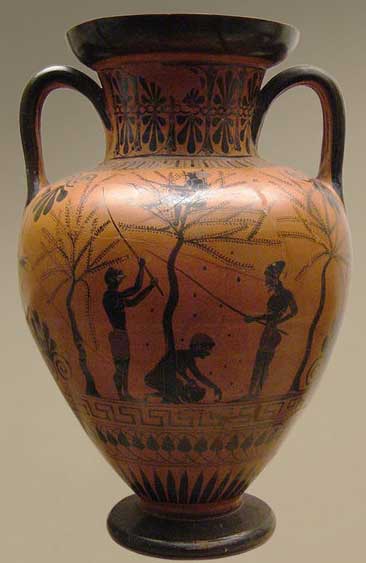
Black-figure neck-amphora by the Antimenes Painter
Scene of olive-gathering by young people
Athens, Greece
Circa 520 BC
British Museum (B 226), London
The Mediterranean climate is characterized by two seasons: the first dry and hot, from April to September (river beds tend to dry up); the second is humid and marked by often violent rain storms brought in by west winds, with mild frost free temperatures. There are variations to this climate. As such in the mountains winters can be rigorous and snowy. Attica, Cyclades, the south of Peloponnese, and Crete are much more arid than the rest of Greece.
Agricultural products
Farming
During the early part of Greek history, as shown in the Odyssey, Greek agriculture - and diet - was based on cereals: barley (κριθαί / kritaí), Durum wheat (πύρος / pýros), and, less commonly, millet or common wheat. The generic term (σῖτος / sitos, usually translated as wheat, could in fact designate any type of cereal grain. In reality, 90% of cereal production was barley. Even if the ancients were aware of the better nutritional value of wheat, the growing of barley was less demanding and more productive. Various attempts have been made to calculate Attican grain production in the period, but results have not been conclusive.
It did not take long for demand to out pace production capabilities. The "tightness" of the land (στενοχωρία / stenokhôría) also explains Greek colonization, and the importance Anatolian cleruchies would have for the Athenian empire in controlling grain provision.
On the other hand, the Greek land was very well adapted for olive trees, which provided olive oil. The growing of olive trees dates back to early Greek history. Olive plantations are a long-term investment: it takes more than twenty years for the tree to provide fruit, and it only fruits every other year. Grapes also do well in the rocky soil, but demand a lot of care. Grapes have been grown since the Bronze age.
These core crops were augmented by vegetable gardens (cabbage, onion, garlic, lentils, chick pea, beans) and orchards (fig, almond, pomegranate). Herbs were also grown (sage, mint, thyme, savory, oregano, etc.), as were oilseed plants such as linseed, sesame, and poppy.
Animal husbandry
Animal husbandry, above all seen as a sign of power and wealth in the works of Homer, was in fact not well developed due to the limitations of geography. While the Mycenean civilisation was familiar with the rearing of cattle, this reduced quickly as a result of geographic expansion into less suitable terrain. Goat and sheep quickly became the most common livestock; less difficult to raise and providers of meat, wool, and milk (usually in the form of cheese). Pork and poultry (chicken and geese) were also raised. Oxen were rare and normally used as a work animal, though they were occasionally used as sacrificial animals (see Hecatomb). Donkeys, mules and their various mixes were raised as pack or draught animals.
Finally, horses were raised on the plains of Thessaly and Argolis; it was a luxury animal, signifying aristocracy. The Clouds, a comedy by Aristophanes, amply illustrates the equestrian snobbery of Athenian aristocrats: Pheidippides, the son of the hero is addicted to race-horses and so ruins his father Strepsiades.
It is likely that most farms practices some limited animal husbandry; poultry or small animals grazing on waste land or fed kitchen scraps. Combined farm/livestock operations also existed, as well as those specializing in livestock. An inscription [3] also mentions a certain Eubolos of Elateia, in Phocis, the owner of 220 head of cattle and horses and at least 1000 sheep and goats. Flocks of sheep were herded between the valley in winter and the mountains in summer. Special taxes existed for the transit or stopover of flocks in cities.
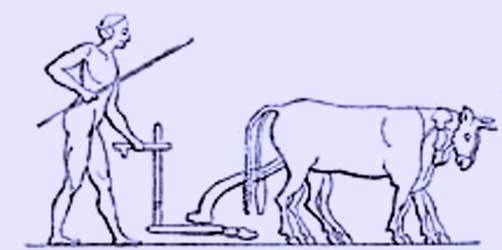
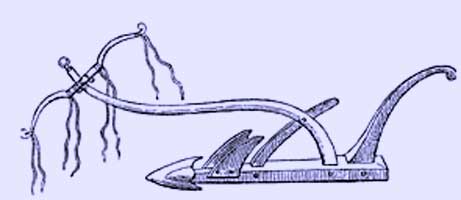
"Arotron"
Other products
Wood was intensively exploited, primarily for domestic use; homes and wagons were made of wood as was the aratrum, or light plough. The great Greek forests located in the highlands were denuded by goats and charcoal production; it was not long before it had to be imported especially for ship production (see trireme).
Finally, beekeeping provided honey, the only source of sugar know to the Greeks. It also used in medicines and in the production of mead.
Agricultural work
Hesiod's Works and Days, 8th century BC and Xenophon's Economy of the 4th century BC provide valuable information about working of the land.
The olive harvest took place from late autumn to the beginning of winter, either by hand or by pole (see illustration). They were then placed in wicker baskets and left to ferment for a few weeks before being pressed. The screw press, although referred to as the Greek press by Pliny the Elder (XVIII, 37) was a relatively late (2nd century BC) Roman invention. Oil was preserved in terra cotta vases for use throughout the year. This was also the time for pruning of trees and vines and harvesting of legumes.
Spring was the rainy season; farmers took advantage of this to bring fallow ground back into production. In effect, they practises biennial crop rotation, alternating from year to year between fallow and cultivated. Attempts to introduce triennial crop rotation with legumes in the third year, ran into problems due to the poor Greek soil, lack of manpower, and absence of mechanization. The Greeks did not use animal manure, possibly due to the low number of cattle. The only soil additive was in effect weeds ploughed back into the ground after fields came out of fallow.
In summer, irrigation was indispensable. In June, they harvested with sickles; the scythe was not used. Wheat was threshed with animal power; it was simply trampled by oxen, donkeys or mules. The grain was then stored. It was left to women and slaves to grind it and make bread.
Autumn was the most important season. In the beginning of autumn they collected deadfall and prepared supplies of firewood; while winters were mild on the coast they could be brutal in the highlands. They also had to break the hard crust that had formed over the summer on grain fields. To do this required three passes; the plough was wooden and iron ploughshares were rare. A hoe and mallet were also used to break clumps of earth. The fallow land for next year was sown by hand. This was also the time of the grape harvest. The grapes were crushed by foot in large vats then the wine was left to ferment in jugs.
In the nearly four centuries that passed between Hesiod and Xenophon, no improvements can be found in agriculture. Tools remained mediocre and there were no inventions to lighten the work of either man or animal. They had to wait for the Romans to invent the water mill, which finally permitted hydraulic power to augment muscle power. Neither irrigation, nor soil improvements, nor animal husbandry saw any advances. Overall, production remained dismal. Only the very richest of land, such as that of Messinia was capable of supporting two crops per year.
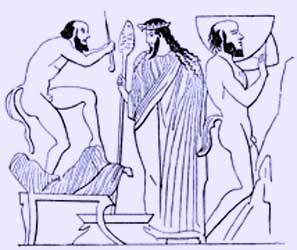
Wine Production by Satyrs
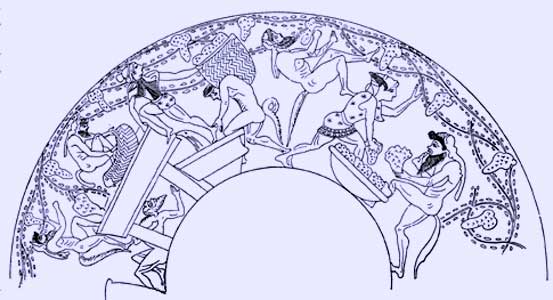
Wine Production by Silenoi and Maenads
Agricultural property
With the exception of Athens, and a few areas where aerial surveys have permitted analysis of historical land distribution, agricultural property allocation is not well known. Before the 5th century BC, it is certain that the land belonged to great landowners, such as the Attican Eupatrides. Nevertheless, land use varied regionally; in Attica domains were divided among smaller plots, whereas in Thessaly they had single tenants
From the 8th century BC, tensions grew between the great landowners and the peasants, who were finding it more and more difficult to survive. This can probably be explained by population growth brought on by reduced infant mortality, and aggravated by the practice of equally subdividing land amongst several inheritors each generation (attested to by both Homer and Hesiod). In Athens, the crisis was resolved with the arrival of Solon in 594 BC, who forbade slavery for debt and other measures intended to help the peasants. In the 5th century BC, the practice of liturgy ( λειτουργία / leitourgia - literally, "public work") placed the responsibility for provision of public services heavily on the shoulders of the rich, and led to a reduction in large scale land ownership. It is estimated that most citizens of hoplite rank owned around 5 hectares of land. In Sparta, the reforms of Lycurgus led to a drastic redistribution of land, with 10 to 18 hectare lots (kleroi) distributed to each citizen. Elsewhere, tyrants undertook redistributions of land seized from wealthy political enemies.
From the 4th century BC onwards, however, property starts to become concentrated among relatively few land owners, including in Sparta where according to Aristotle, the land has passed into the hands of a few (Politics, II, 1270a)[4]. Nevertheless, the great aristocratic estates in Greece never achieved the scope of the great Roman latifundia; during the classical period, the wealthy Alcibiades possessed only 28 hectares (Plato, 1 Alcibiades, 123c)[5]. In all cases, land remains intimately associated with the concept of wealth. The father of Demosthenes possessed 14 talents and for land owned only a home, but he was the exception. When the banker Pasion made his fortune, he hurried to buy land.
Finally, a not insignificant portion of Greek land was public and/or sacred. Each city possessed such land and it is estimated that in Athens during the classical period these lands represented a tenth of cultivable land. This was an administrative division and the property of the city itself (for example in Attica, it was a deme) or a temple. These lands were leased to generally fortunate individuals.
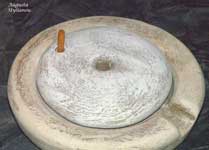
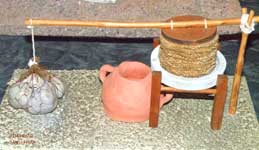
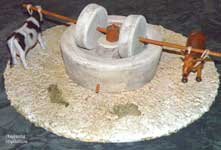
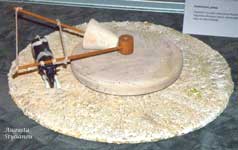
Oil press, Stone olive press, An animal-driven mill,
Olive cultivation in ancient Greece: seeking the ancient economy, Lin Foxhall
Notes
- ^ As estimated by L. Migeotte, L'Économie des cités grecques, p. 55.
- ^ This article was initially translated from the French wiki article fr:Agriculture en Grèce antique on 10 June 2006.
- ^ Migeotte, Leopold. L'emprunt public dans les cités grecques. Recueil des documents et analyse critique, Sphinx and Belles Lettres editions, Quebec-Paris, 1984.
- ^ Aristotle in 23 Volumes, Vol. 21, trans H. Rackham 1944 online at http://www.perseus.tufts.edu/cgi-bin/ptext?doc=Perseus%3Atext%3A1999.01.0058&query=book%3D%232&chunk=book accessed 10 June 2006
- ^ Plato in Twelve Volumes, Vol. 8 trans W.R.M. Lamb 1955 online at http://www.perseus.tufts.edu/cgi-bin/ptext?doc=Perseus%3Atext%3A1999.01.0176;query=section%3D%23100;layout=;loc=Alc.%201.123d accessed 10 June 2006
Bibliography
- Marie-Claire Amouretti :
- (French)"L'agriculture de la Grèce antique. Bilan des recherches de la dernière décennie", Topoi. Orient-Occident, 4 (1994), p. 69–94,
- (French)Le Pain et l'huile dans la Grèce antique. De l'araire au moulin, Belles Lettres, Paris, 1986 ;
- (French)Anne-Marie Buttin, La Grèce classique, Belles Lettres, coll. "Guide Belles Lettres des civilisations", 2002 (ISBN 2-251-41012-0) ;
- (French)Marie-Claire Cauvin, Rites et rythmes agraires, Maison Orient-Méditerrannée, Lyon-Paris, 1991 ;
- (French)Moses Finley, Le Problème de la terre en Grèce ancienne, Mouton, Paris-La Haye, 1975 ;
- Signe Isager and Jens E. Skydsgaard, Ancient Greek Agriculture: An Introduction, Routledge, 1995 (ISBN 0-415-11671-6) ;
- Léopold Migeotte :
- (French)L'économie des cités greques, Ellipses, coll. « Antiquité : une histoire », Paris, 2002 (ISBN 2-7298-0849-3),
- (French)L'emprunt public dans les cités grecques. Recueil des documents et analyse critique, éditions du Sphinx et Belles Lettres, Québec-Paris, 1984 ;
- (French)Claude Mossé, Annie Schnapp-Gourbeillon, Précis d'histoire grecque, Armand Colin, coll. « U », 2003 (2nd ed) (ISBN 2-200-26562-X).
| Ancient Greece
Science, Technology , Medicine , Warfare, , Biographies , Life , Cities/Places/Maps , Arts , Literature , Philosophy ,Olympics, Mythology , History , Images Medieval Greece / Byzantine Empire Science, Technology, Arts, , Warfare , Literature, Biographies, Icons, History Modern Greece Cities, Islands, Regions, Fauna/Flora ,Biographies , History , Warfare, Science/Technology, Literature, Music , Arts , Film/Actors , Sport , Fashion --- |
Retrieved from "http://en.wikipedia.org"
All text is available under the terms of the GNU Free Documentation License

